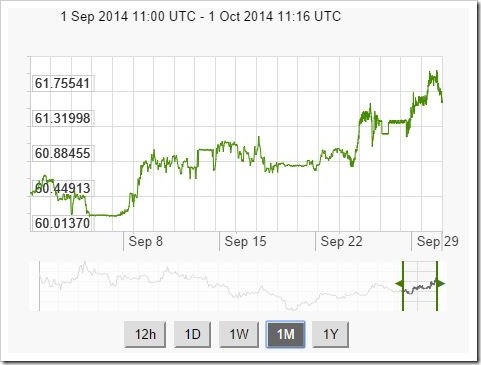The Indian rupee fell sharply by 2.1% on September 30, 2014, the worst plunge it has taken after the august 2013 debacle when it fell by an unimaginable 8.8%!!
The rupee ended the day at 61.7450 / 61.7550 per dollar compared with Monday’s close of 61.53 / 54.

“Much of the recent rupee weakness has reflected dollar strength and a pick-up in foreign-exchange volatility, reducing risk-adjusted interest-rate differentials,” Hamish Pepper, a currency strategist at Barclays Plc in Singapore, said in an e-mail interview. “However, material rupee depreciation remains unlikely,” he said, citing “relatively low inflation and enhanced RBI policy credibility.”
RBI Governor Raghuram Rajan left interest rates unchanged for a fourth straight meeting today and cited significant risks to his target of slowing inflation to 6 percent by January 2016.
The depreciation of the rupee notwithstanding, the financial analysts assure that this should not be a cause of concern. That is partly because the rupees is not the only currency which has weakened as compared to the dollar. The much more stronger Euro and Yen are struggling as well. While the yen has touched a six year low against the dollar, the euro is not far behind and has fallen to its lowest value in two years.
“The dollar has been gaining, with the yen and euro both struggling against it,” said Manis Thanawala, director at Greenback Forex, a currency risk advisory firm in Mumbai.
Unlike august 2013 when the rupee had hit the rock-bottom due to domestic fiscal problems, the current weakness has been caused by factors outside the Indian economy. Most noteworthy of all is the US dollar getting stronger vis-a-vis all major currencies.
That should bring some cheer to the average American as well because the fiscal deficit is down, the market is upbeat and the consumer confidence is high. That should be taken as a clear indication of the fact that the economy is looking up, after a long time.
On the contrary, it has the man on the American streets worried that the Federal Bank might want to push up the interest rates as a result of this changed scenario.
According to Fitch, the US central bank will complete the ‘tapering’ of its asset purchase programme in October and the first increase in the Fed’s short-term policy interest rate should be expected in mid-2015.
Now, THAT could be something to worry about. If the Federal bank raises its interest rates, India might witness a reversal of portfolio flows creating pressure on the rupee.
The rate differential will further narrow if the RBI cuts interest rate to boost domestic growth. However, the central bank says it will cut rates only if inflation subsides to 6 per cent by 2016. Economists expect a rate cut in fiscal year 2015-16 now.
Currency expert Jamal Mecklai suggested that the government can avoid these sharp fluctuations on the value of currency by allowing different kind of players and opening up the Indian currency market for foreign investors as well. At present, only bankers, exporters and importers can trade in the currency market through currency dealers.
Three things can help support the Indian currency:
- Higher import cover
- Reduction in current account deficit , and
- An increase in FDI.
Ever since the new government took over earlier this year, the current account deficit has fallen to 1.7%, the import cover has improved to 8.5 months and the FDI is getting a major boost with the government going all out to woo foreign investors.
Keeping all these factors in mind, the rupee should be able to hold itself within the 58- 62 range against the dollar, without giving anyone any sleepless nights.

HELLO MAM I’M AASHISH SHARMA FROM KANPUR UTTAR PRADESH CAN I SUBMITT HIM IN YOUR PROJECT PLZ I WANTED TO DO SOMETHING ABOUT WORLD AND MY INDIA PRESENTLY I WORKIG IN A MULTI SUPER SPECILITY HOSPITAL MY CELL IS 09889500103.